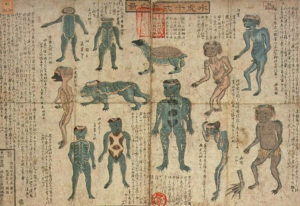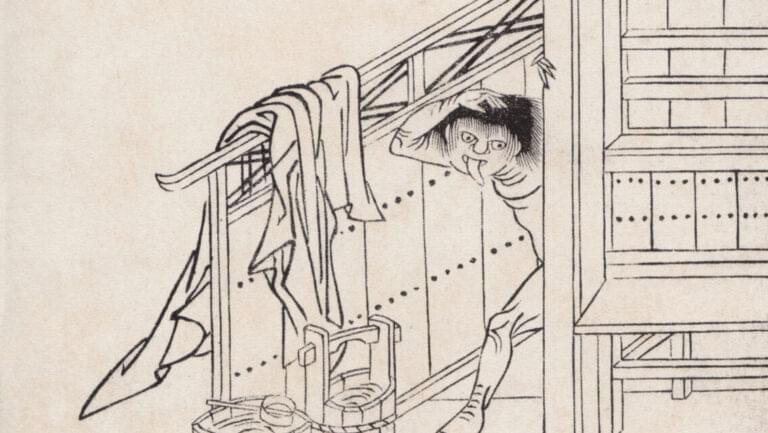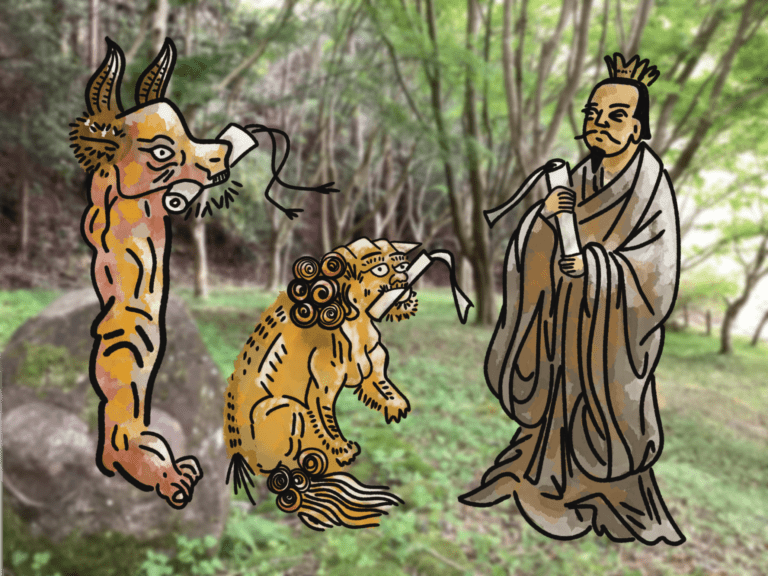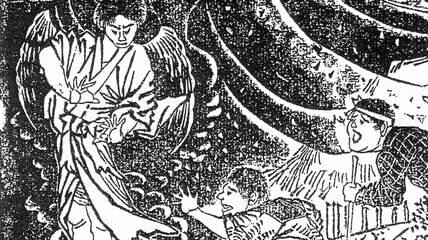A kappa is a small, scrawny, aquatic yokai with a parrot-like beak, a tortoise-style shell on its back, and an indentation on the top of its head full of water. They’re found in rivers, lakes, ponds, and even coastal areas. But what do they do?
While recently kappa have been rebranded to be very kawaii, that hasn’t always been the case. Listen to the newest episode of Uncanny Japan to find out how heinous these slimy critters can be.

Hey hey, everyone, it’s Terrie, and I’d like you all, reach over and knock on wood. I don’t know if you’ve noticed or not, but I’m actually getting the podcast out on a schedule this year. And that schedule is a new episode the 15th and 30th of every month. Or thereabouts. Okay, don’t look back, it’s not exact yet, but it is gravitating that way.
Listen. Hear that? Rain again. And, again, it’s welcome because today’s topic is a creature that just loves the water. The kappa.
Kappas are pretty cool and I’m going to talk about all kinds of stuff. Later on, and I’ll let you know when, I’m going to tell you about the kappas obsession with butts and I briefly mention dead bodies floating down rivers and what that entails. It might get a little gross. So a heads up there. But before we get to that fun stuff.
For those of you who don’t already know, let me describe what a kappa looks like by telling you quickly about the first time I ran across one. I was just married and we were visiting Mount Fuji, probably one of the five lakes. We were exploring and come across a shrine, and next to it was this smallish wooden structure, tall but narrow. Obviously very old, aged wood covered in moss. But what drew my attention was that all across the front were these bars. “I wonder what they don’t want to escape”, I joked, and went over to investigate. There behind the bars was this tall dark frightening statue. It was standing upright, but not human. It had webbed hands and feet, a thick beak for a mouth, with this wild spiky hair sticking out all over the place. It also had what looked like a large shell on its back, but what I remember most were these really scary penetrating eyes. I remember it had this presence about it that gave me goosebumps. I was told that the creepy caged creature was a kappa, but that wasn’t enough information. With no Internet to consult, I began to ask everyone I could what was a kappa and what did it do. This was actually my first experience with a Japanese yokai and it still has a special place in my heart.
Speaking of yokai, the kappa is one of the big three if you remember me talking about them in past episodes. The other two being the oni (I talked about them a little in episode 37) and the tengu (episode 32 and 34).
The kanji for kappa is the character for river and child. River child. Remember that because it’s going to come back later in a horribly grotesque way. Kappa also go by some other names like: kawa-taro, kawa-ko, kawaranbe, or gatarou.
Like I said, the kappa love and live in water. You name it: rivers, lakes, ponds, and sometimes there are stories of them dwelling along the coast. While they live in the water and need it to survive, they can also come on land to play pranks or wreak havoc.
Although there are some differences in appearance, it’s pretty hard to miss one of these guys. A little more description before I go on. They’re usually the size of a child, aged around 6 to 10 years old. Bipedal but not always. Sometimes they can be seen scampering about on all fours. Their skin is green or yellow, slimy and sometimes scaled. I mentioned the webbed hands and feet, thick parrot-like beak, and tortoise-like shell on the their backs.
One thing I didn’t notice in the statue at the shrine that first time, is that all that spiky hair surrounds an indentation on the top of their heads that holds water or some say a magic liquid. That’s important because kappa are super strong. Strong enough to pull large farm animals like horses and cows into the water and drown them. They also love playing sumo and if not doing more heinous things, might challenge you to round. No matter how strong you are, even though these guys are short and scrawny, you’ll lose. Like I said, they’re way strong. And it’s believed that it is the water on the top of their heads that gives them this enormous strength. If that water ever dries up or spills, they become very weak, and easily defeated or captured.
Now, what do kappa do? Are they good guys or bad guys? While these days you can very often find cute, bubbly, goof ball kappa on everything from pencil cases, key chains, to appearances in adorable manga and anime, their real character is much more horrific.
Before we go full horror, some more light-hearted stuff. Kappa are very good with medicine, especially bone setting. There have been stories of people who have captured a kappa and only released the beast when it promised to teach them some medicine or bone setting stuff. This seems to have happened a lot during the Edo Era.
Kappa love cucumbers. Especially the tiny little flowers that bloom on the vines. If you’ve ever eaten kappa maki (a cucumber stick rolled in sushi rice), and you didn’t know before, now you know how it got its name.
Have you ever heard of or been to Tokyo’s Kappa Bashi? It’s the area between Ueno and Asakusa where you visit if you want anything cooking or restaurant related. Pots and pans, utensils, lanterns and those super realistic food samples, too. Now there are at least two stories about the name Kappa Bashi.
One is that it came from the word cappa, a Portuguese word adopted by the Japanese that means raincoat. I’ve read that it refers to the straw raincoats worn back in the day. But I still hear people all the time referring to their raincoat as their cappa. There was a cappa salesman, a cappa-ya, and that’s one story of where the name Kappa Bashi comes from. Since it’s a homophone for the yokai kappa, the area has taken the kappa as their mascot. You can find statues and signs of kappa all up and down the street as well as a shrine, the Kappa Dera.
But there is a second story about how way back when, the area was mostly farmland that often flooded. The story here is that in the late 1700s there was a man name Kihachi who used his entire savings on the construction of a canal to prevent flooding in the area. It was so expensive and taking way too long. Then one day a kappa swam in from the Sumida River to help. It was a kappa evidently that Kihachi had saved years before. The kappa did what he could and the construction was finished and a kappa temple was built. It is still there to this day. I’ve been several times and always there are offerings of cucumbers piled up which is sweet. It’s called Sougenji is said to house a mummified kappa arm.
I actually have a personal story about how my son when he was four year old and his friends were invited to Kappa Dera. I tried to put it in this episode, but it got real long so I’ll put it up on Patreon for my buddies there.
Now let’s get gory a little bit. Kappa as real jerks. Kappa are known to drown people and animals, but especially children who play unattended in water. This drowning by a kappa is actually has a name, gappa doko.
Remember that kappa love cucumbers? Well, I read that some mother’s used to write the name of their children on cucumbers and drop it into the nearby river or lake, a kind of offering to the kappa asking it to please spare their child’s life if he or she happens to go swimming there. You can still find signs near bodies of water with an image of a kappa on them, warning children not to swim there. Some believe the whole idea of the kappa was a way to scare children from unattended water play, and possible drowning.
Now for the butt talk. There is a mythical ball that is said to reside inside everyone’s rectum. It’s called the shirikodama and kappa love this. Shiri meaning butt, dama meaning ball. They love stealing it. But when the do the person dies. I read a slightly different version that states that they actually remove it so they can get to a person’s liver, which they suck out. No matter. It’s not something you want to lose.
When you’re looking at paintings or images of a kappa you will sometimes see it holding a cucumber, or perhaps something round. That round thing is the shirikodama that it has just pulled out from some poor now deceased victim.
I always like to try to figure out how these creatures came about. Something had to inspire these beasties and their stories.
A very interesting one is that the image of a Kappa is based on the first sightings of Portuguese monks who landed in Japan in the 16th century. Japanese had never seen such people. The tops of their heads were shaved, hair sticking out around the bald spot. Bigger noses than they were used to, I’m guessing. And they wore robes that had long hoods dangling from their backs, possibly resembling a shell?
Another particularly grotesque theory is about how, again, back in the day, unwanted children were sometimes thrown into rivers to be carried away. Perhaps downstream, other children would run across these poor things, freak out, run home and the mother might have said, stay away from the river, those are river children. Kappa.
A theory about the oshirikodama that I think is kind of brilliant albeit gross, is that when people drown, naturally, as they decay their shall I say bottom orifice expands. Again, maybe, hundreds of years ago when these poor souls were fished out of the water and this was noticed, someone came up with the idea that perhaps a kappa had reached in to grab something. What? An oshirikodama!
Okay, let me wind up with a couple kappa sayings. The first is “kappa no kawa naagare”, or even a kappa can get carried down a river or drown. Kappa are very skilled swimmers, obviously. So the saying basically means, even an expert can make a mistake. Then there’s he no kappa or kappa no he. A kappa’s fart. Kapp’s fart and they do it a lot evidently so when something is very easy to do, or much ado about nothing, you can say “he no kappa” or “kappa no he”.
So there you have the kappa, the slimy, dastardly, sometimes adorable Japanese aquatic beastie.
If you like the show please consider supporting us on Patreon. Even a little bit is very much appreciated. For only five dollars you can get a monthly Bedtime story, translated, retold, and narrated by me. There’s also occasional binaural only sounds, behind the curtain Patreon-only episodes (for example I’m going to put up the story about how I brought Halloween to my neighborhood in a big way, toddlers dressing up like kappa and an invitation to kappa dera. Oh, and an Uncanny Japan sticker. All Patrons, if they want, get an sticker.
Thank you everyone for listening, supporting, reviewing, reaching out, and otherwise rooting for me. It means a lot. And I’ll talk to you again real soon.
Bye bye!
Credits
Intro and outro music by Julyan Ray Matsuura






